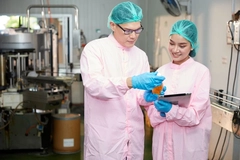Joint health goes mainstream: Younger consumers drive demand for mobility supplements

Demand for joint health solutions is growing among younger consumers wanting to live an active lifestyle for longer. This demand is partly driven by new technologies that help consumers track mobility and recovery. In response, the nutrition industry is exploring solutions that meet the demands of healthy, active young adults and an aging population.
Nutrition Insight explores how nutraceutical businesses target diversifying consumer segments with convenient and efficacious offerings with Balchem, OmniActive Health Technologies, and Giellepi.
Jessica Arnaly, senior marketing and business development manager at Balchem Human Nutrition & Health, says the rise of “agelessness” is shaping the whole nutrition industry, including the mobility segment.
“What’s even more interesting is the shift in who’s buying products for mobility. Traditionally, this category was marketed to elderly people, whereas now we’re seeing a growing interest from younger people looking to future-proof their well-being.”
She affirms that this opens new opportunities for supplement brands to target a broader audience. “From older consumers who wish to support their mobility so they can comfortably move through daily tasks, to younger, health-conscious individuals who proactively take steps to maintain their physical activity later in life.”
Keya Shah, director of Category Management, Joint Health and Mobility at OmniActive Health Technologies, adds that the joint health’s “outdated feel” of commoditized ingredients and dated claims is a crucial challenge for companies in the space.
“However, this creates a real opportunity for brands that innovate with clinical backing, measurable results, and fresh formats,” she highlights. “With early benefits and long-term science-backed outcomes, consumers may benefit from efficacious solutions that work. We anticipate a rise in consumer stickiness and adoption, leading to repeat purchases that reinvigorate this space.”
New consumer segments
Claudia Antenozio, scientific marketing at Giellepi, says a global shift toward preventive and proactive wellness is driving bone and joint health product growth. Where aging consumers seek to preserve mobility and avoid age-related decline, younger consumers turn to supplements to maintain an active lifestyle and performance.
“This has led to a surge in demand for nutritional solutions that support mobility, flexibility, and long-term joint function,” she explains. “This emphasis on nutrition and supplementation as a foundational tool for healthy aging is reshaping the category, pushing brands to innovate with scientifically backed, functional ingredients and convenient formats.”
 Shah says the cross-category appeal of joint support in sports and healthy aging opens doors in women’s health, workplace wellness, and fitness recovery.Shah says OmniInsights, OmniActive’s consumer insights team, reported a notable uptick in consumers under 50 seeking joint support solutions to optimize performance, recovery, and everyday comfort, including athletes and people with an active lifestyle.
Shah says the cross-category appeal of joint support in sports and healthy aging opens doors in women’s health, workplace wellness, and fitness recovery.Shah says OmniInsights, OmniActive’s consumer insights team, reported a notable uptick in consumers under 50 seeking joint support solutions to optimize performance, recovery, and everyday comfort, including athletes and people with an active lifestyle.
This cross-category appeal of joint support in sports and healthy aging opens doors in “unexpected spaces,” such as women’s health, workplace wellness, and fitness recovery.
“This shift is also changing the product format landscape. There is strong interest in convenient delivery systems such as gummies, powders, and stick packs, especially among millennials and Gen Z, to fit their lifestyles.”
Balchem’s Arnaly urges brands to analyze the unique needs of this wide range of consumers interested in mobility solutions. “Understanding these differences is key to developing effective solutions that meet consumers where they are.”
“Fitness enthusiasts, for example, are looking for products that aid in joint and muscle recovery after intense workouts, while for older adults, the focus shifts to staying active in their daily lives — whether lifting grandchildren, running errands, or simply moving with ease.”
To help brands tap into the joint health market and diversify their portfolio, Balchem offers OptiMSM, a source of methylsulfonylmethane (MSM), which is a staple ingredient for mobility. “Healthy joints depend on cartilage to function properly, providing a buffer between the bones and helping reduce friction to enable normal movement.”
Multifunctional solutions
Shah points to OmniActive’s Muvz ingredient to address different consumer groups, which approaches mobility from multiple angles.
 Antonozio points to differentiation as one of the most significant challenges in a joint health market saturated with products making generic claims.Muvz is made from a blend of two botanicals known for their analgesic, anti-inflammatory, and antioxidant properties. It supports several aspects of mobility.
Antonozio points to differentiation as one of the most significant challenges in a joint health market saturated with products making generic claims.Muvz is made from a blend of two botanicals known for their analgesic, anti-inflammatory, and antioxidant properties. It supports several aspects of mobility.
“With three clinical studies, Muvz addresses mobility through joint, low back support, and improved physical functionality, making it relevant for active lifestyles, aging populations, high-performing adults, and those who might have desk jobs or sit for prolonged periods.”
“In one of the randomized, double blind, placebo-controlled clinical studies, Muvz demonstrated a same-day reduction in knee joint pain following exercise versus the placebo group,” she details.
“It helps meet the needs of various demographics, such as everyday athletes and active consumers, working professionals, and seniors who want to be active and mobile.”
Formulating for the future
Antenozio from Giellepi says that the future of joint health and mobility lies in addressing the diverse needs of different age groups who want to live an active lifestyle.
“This shift opens the door for innovation in ingredient science, delivery formats, and personalized solutions. Brands that invest in clinically validated, consumer-centric products will be best positioned to capture the evolving demand in this fast-changing segment.”
“It’s an exciting time for the category, with real opportunities for brands to build trust, prove efficacy, and stay ahead of shifting consumer behaviors.”
Antonozio also observes a rising demand for faster-acting, natural, and multifunctional products beyond basic joint maintenance. “Consumers are increasingly looking for solutions that also improve mobility, flexibility, energy, and recovery, and that align with modern expectations around clean label formulations and scientific credibility.”
 AI is a game-changer, says Arnaly, helping brands analyze market trends to create solutions tailored to individuals’ specific needs.Meanwhile, she highlights differentiation as one of the most significant challenges in the sector. “The market is saturated with products making generic claims, often without strong clinical support, making it difficult for consumers to identify truly effective solutions.”
AI is a game-changer, says Arnaly, helping brands analyze market trends to create solutions tailored to individuals’ specific needs.Meanwhile, she highlights differentiation as one of the most significant challenges in the sector. “The market is saturated with products making generic claims, often without strong clinical support, making it difficult for consumers to identify truly effective solutions.”
Technology driving innovation
The experts note the transformative role that technology plays in the nutrition market. Antonozio says technological advances affect both product development and how these solutions are delivered to consumers.
“Advances in botanical extraction, ingredient standardization, and bioavailability enhancement are enabling the creation of more effective, fast-acting formulations. Innovations such as liposomal delivery systems, microencapsulation, and precision fermentation help improve absorption, stability, and targeted action.”
“On the application side, digital health tools and wearables are also shaping the market by helping consumers track mobility, discomfort levels, and recovery, fueling interest in personalized, measurable nutrition solutions,” she highlights.
Meanwhile, Antonozio says technology supports rapid clinical validation through more efficient trial designs and biomarker tracking, making it easier for brands to market science-backed, consumer-trusted products.
Arnaly from Balchem adds: “AI is another game-changer, helping brands identify and analyze market trends to create personalized solutions tailored to individuals’ specific needs.
Moreover, she notes that advanced research tools can help enable more profound insights into how ingredients may impact joint function and drive innovation in formulation.
OmniActive uses technology in ingredient development and formulation lifecycles. Shah details that the company leverages advanced delivery systems and extraction technologies to ensure the performance of its core joint health ingredients, Curcuwin Ultra+ and Muvz, across formats.
“For instance, Curcuwin Ultra+ leverages Ultrasol technology for superior absorption and efficacy with formulation flexibility,” she explains. This bioavailable curcumin has been clinically shown to help promote joint comfort and mobility.












